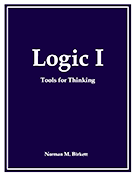This is the first of what author Norman Birkett plans to eventually be a four-six year course in logic and rhetoric for students in grades 7 through 12. While most texts for junior high begin with the logical fallacies, this text takes a different approach. It is a survey course written from a Christian perspective. It introduces “the tools and techniques of logic, and how to use them” (p. xiv). It encompasses some of what we consider formal and informal logic but it's not a comprehensive treatment of one or the other. It introduces what the author calls “moleculan,” another, less-intimidating name for sentential or propositional calculus. Birkett's book fits into a classical curriculum, but it employs current mathematical thinking. Symbols and mathematical language are used but with a gentle introduction to prevent students from getting overwhelmed. Birkett purposely injects humor throughout the book; he tells us, “Learning is hard work, and it ought to be hard work, but that doesn't mean it can't be enjoyable“ (p. xiv).
This is a challenging course that will be suitable for only advanced seventh graders, while many eighth graders and high school students should find it manageable. The student book boasts about 300 pages and the Teacher's Manual has about 200, so clearly there is more content than in some other courses for this level. The author recommends using it as an introduction to Martin Cothran's Traditonal Logic I. The teacher without a background in logic should be able to teach the course with the assistance of the Teacher's Manual, however this will require some study and lesson preparation. The Teacher's Manual has extensive introductory material that should prove helpful plus teaching notes and answers to exercises for every chapter. Students can do some work independently, but the course requires some teaching and discussion. It should work best with some group class work each week. The course was developed in a Christian school setting with classes meeting three times a week for approximately 40-minute class sessions.
The Teacher's Manual comes with a reproducible test packet with tests covering from two to four chapters each. Answer keys to the tests are included. A “Quick Reference” in the back of the student book summarizes key concepts for quick look up.
While Logic I is not an apologetics course, it does reflect a biblical Christian, Protestant worldview and contains some examples centering around controversial questions Christians encounter.









